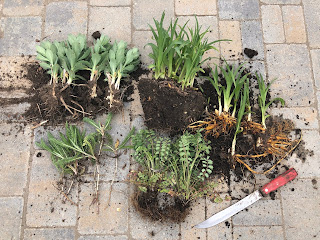by Pat Tormey
“Many home gardeners have found that the process of division is more traumatic to them, the gardener, than it is to the perennial.” www.cce.cornell.edu/chemung
Ah, if only we could put in our flowering plants and forget them. Unfortunately, most perennials, those ‘backbones’ of the garden, may require occasional division in order to thrive. As your plants grow over the years with new stems and new roots, they become over-crowded. The plant may look larger, but each stem is actually smaller and weaker.
If your perennial plants show any of the following, it may be time to rejuvenate them through division:
1. The flower quantity or flower size is reduced.
2. The stems and branches are tangled.
3. The center of the plant dies leaving a doughnut of new growth around the perimeter.
4. The plant loses vigor, flopping over or requiring staking when it never did before, or the leaves are paler or yellow.
5. The plant has out-grown the space you have given it. This is especially likely if it grows in a particularly hospitable site.
6. The plant is in the ‘wrong place’ in your garden.
7. You want to share the bounty of your garden plants with friends and neighbors. It is illegal to divide perennials that are patented.
 |
Starting from the top and going clockwise: Daylilies, whole and divided. A fibrous-root plant, cut in half. Yarrow just pulled apart. Sedum pulled and cut as needed.
Many perennials in our area do best by being divided in the spring – right now! The general rule is that summer and fall blooming plants should be divided in the spring, and spring blooming plants in the fall.
Tips for successful division of fleshy, fibrous, tuber, and rhizome perennials
1. The day before, water the plant thoroughly.
2. Try to select a day that will be overcast and not too hot. Then work either in the cool of morning when the plant is fully hydrated or late afternoon when the night will allow for better recovery. Exposed roots dry out quickly.
3. Dig the hole the divisions are going into, or prepare pots for them.
4. Some plants benefit by having their top foliage cut back, allowing you to see where the natural divisions occur when making your cuts and reducing the loss of water through the leaves after transplant.
5. If the plant is large, use a spading fork to dig all the way around it, well away from the base to minimize the loss of roots. A fork does less damage to the roots than a shovel or spade. Then lift the entire clump out of the ground. You may need to remove some of the dirt in order to see the root structure.
6. If the whole plant doesn’t require division and you only want few new plants, you can dig or cut out clumps around the edges. The parent plant will recover quickly and appear unchanged.
7. Remove all weeds and grasses before you replant! Inspect the plant for unhealthy parts, usually an old woody center or rotten roots. Eliminate them.
8. For fibrous rooted plants, use a spade (or two), an old bread knife, or your fingers to separate the clump into plants the size you want. Very old and well established perennials, like day lilies or astilbe may require more aggressive handling. I have heard of people using saws!
9. Keep the divisions moist and shaded. Save the youngest pieces for replanting, usually the ones at the edge of the plant. Each piece should have roots and a minimum of 2 buds / piece of the crown. Discard the rest. The larger the pieces, the sooner the plant will bloom again.
10. Plant each division in a hole twice its size. Fill in with good quality soil mixed with organic matter, keeping the plant at its original depth. Don’t feed with nitrogen until the following year - nitrogen encourages top growth and the divisions need to focus on their roots.
11. Water well. If the weather is especially hot and sunny, you may need to add a sunshade for a few days.
There are a number of other techniques for propagating plants, shrubs and trees: stem, leaf or root cutting, layering, grafting, budding, scaling, scooping, scoring, offsets, runners, etc. They are beyond the scope of this article; but what fun they might be!
See http://planttalk.colostate.edu/topics/annuals-perennials/1018-perennials-how-to-divide/ for more details.
Pat Tormey retired and moved to Steamboat in 2014 where she quickly learned that raising plants in this environment was very different than the decades spent raising vegetables in the Midwest. She took the Master Gardener class (2015) and has enjoyed learning more about gardening every year since. Currently, Pat is helping out with the We Dig It! project, raising vegetables for Lift-Up at the Community Garden, and volunteering at a local farm-to-table project.

No comments